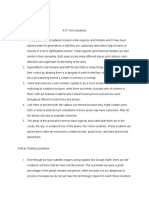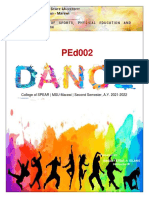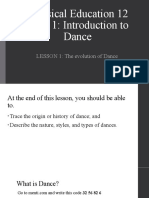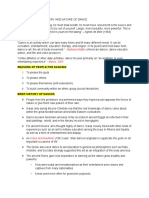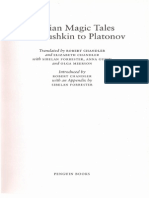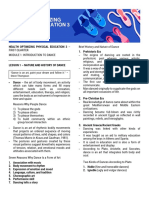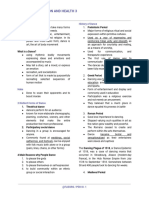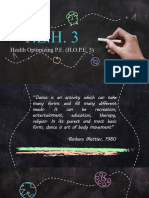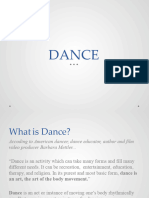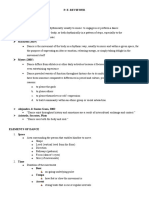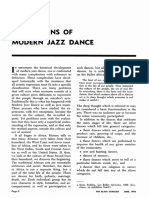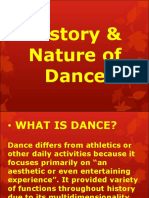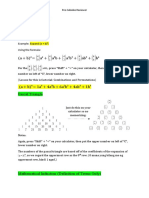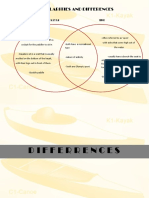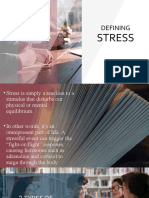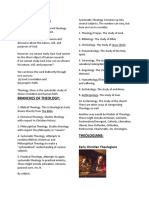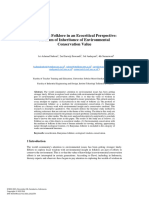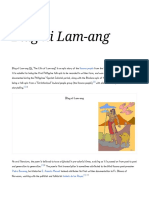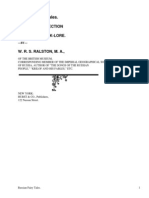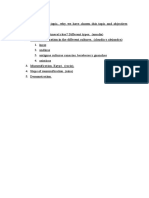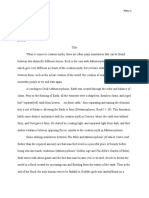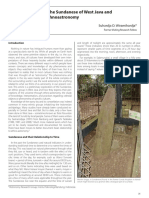0 ratings0% found this document useful (0 votes)
147 viewsMidterms: Pe Reviewer
Midterms: Pe Reviewer
Uploaded by
nd555CHAPTER 1: BRIEF HISTORY AND NATURE OF DANCE
CHAPTER 2: Elements of Dance
CHAPTER 3: Dance Appreciation and Composition
CHAPTER 4: DANCE AS AN ART
Copyright:
© All Rights Reserved
Available Formats
Download as DOCX, PDF, TXT or read online from Scribd
Midterms: Pe Reviewer
Midterms: Pe Reviewer
Uploaded by
nd5550 ratings0% found this document useful (0 votes)
147 views9 pagesCHAPTER 1: BRIEF HISTORY AND NATURE OF DANCE
CHAPTER 2: Elements of Dance
CHAPTER 3: Dance Appreciation and Composition
CHAPTER 4: DANCE AS AN ART
Original Title
MIDTERMS: PE REVIEWER
Copyright
© © All Rights Reserved
Available Formats
DOCX, PDF, TXT or read online from Scribd
Share this document
Did you find this document useful?
Is this content inappropriate?
CHAPTER 1: BRIEF HISTORY AND NATURE OF DANCE
CHAPTER 2: Elements of Dance
CHAPTER 3: Dance Appreciation and Composition
CHAPTER 4: DANCE AS AN ART
Copyright:
© All Rights Reserved
Available Formats
Download as DOCX, PDF, TXT or read online from Scribd
Download as docx, pdf, or txt
0 ratings0% found this document useful (0 votes)
147 views9 pagesMidterms: Pe Reviewer
Midterms: Pe Reviewer
Uploaded by
nd555CHAPTER 1: BRIEF HISTORY AND NATURE OF DANCE
CHAPTER 2: Elements of Dance
CHAPTER 3: Dance Appreciation and Composition
CHAPTER 4: DANCE AS AN ART
Copyright:
© All Rights Reserved
Available Formats
Download as DOCX, PDF, TXT or read online from Scribd
Download as docx, pdf, or txt
You are on page 1of 9
CHAPTER 1: BRIEF HISTORY AND NATURE The Greek also used dance to aid
OF DANCE education in general as philosophers such
as Plato, Aristotle, and Socrates strongly
“Before man can do anything, he must draw
supported this art as an integration of the
breath, he must move. Movement is the source
body and soul.
and condition of life. To dance is to be out of
yourself. Larger, more beautiful, more powerful. The ancient Rome gave less importance
This is power, it is glory on earth and it is yours to dancing as the nation grew wealthy and
for the taking” – Agnes de Mille (1963) powerful.
DANCE • It became brutal and
sensationalized as their
“Dance is an activity which can take many forms
entertainers were slaves and
and fill many different needs. It can be recreation,
captives from many nationalities.
entertainment, education, therapy, and religion. In
its purest and most basic form, dance is art, the • It was used more often for
art of body movement.” - Barbara Mettler gruesome purposes.
(American dancer, dance educator, author, and
• It eventually became an integral
film and video producer)
part of the corruption in the latter
“Unlike athletics or other daily activities, dance days of the Roman Empire,
focuses primarily on “an aesthetic or even resulting in the condemnation of
entertaining experience” - Myers, 2005 dance by the early Christians.
REASONS OF PEOPLE FOR DANCING In fact, Plato himself immensely gave
importance to dance in education as
1. To please the gods
stated in his elucidation on the Laws. He
2. To please others highlighted the two kinds of dance and
music: the noble (fine and honorable) and
3. To please themselves (self-expression) the ignoble (imitating what is mean or
4. To build community within an ethnic group ugly).
(social interaction) After the fall of Rome, the history of dance
BRIEF HISTORY OF DANCES transformed following the development of
the Catholic Church, which was by then
People from the prehistoric era performed the sole custodian of learning and
ways they hoped would appease the education as well as the source of morals.
forces of nature or give them new powers During this time, theatrical entertainment
of their own. was prohibited and dance was performed
only during worships, church services, and
It was only during the pre-Christian era
religious ceremonies.
that the real knowledge of dance came
about within the great Mediterranean and Although the Church had condemned
Middle Eastern civilizations. dance as entertainment, some singers,
dancers, poets, actors, musicians, and
Dance became full-blown and was richly
jugglers continued to wander in village
recorded in ancient Egypt as reflected in
squares to perform during the Dark and
their wall paintings, reliefs, and in the
early Middle Ages
literary record in hieroglyphs.
• These performers were eventually
For ancient Greeks, who thought highly of
welcomed in the castles and
dance, it was closely linked with other
chateaus of feudal lords.
kinds of experiences such as an aid to
military education among the boys in • The common people also amused
Athens and Sparta, as well as a form of themselves by doing dances that
entertainment and display. were social in character, marking
the beginning of social dancing.
As Kraus and Gaufman (1981) said, “Man
danced originally to supplicate the gods The peasants performed two basic types
on all important occasions of life”. of dancing: the round dance and the
couple dance. In round dance, dancers • Helps improve and maintain bone density,
hold each other by hand, forming a long thus helping prevent osteoporosis
chain and move about in an open or
• Helps recover coordination and
closed circle, or in an extended line.
neuromuscular skills after injury
Couple dance, at that time, was not as
popular as round dance as it was MENTAL/EMOTIONAL
considered scandalous when first seen.
• Helps keep the brain sharp
Nobility soon followed the peasants’ lead
in dancing but in a more refined and • Decreases incidence of dementia and
courtly form as court dances emerged as Alzheimer’s disease
part of the chivalric way of life. • Decreases depressive symptoms
During the Renaissance, dance, and art in • Increases self-esteem and improves body
general, was wholly accepted and gained image
impetus.
• Aids in releasing emotional and physical
• The old restraints were loosened tension
and clerical ideas and purposes no
longer dominate all creative SOCIAL
expressions of the human spirit.
• Gives sense of togetherness within a
• The entertainers now became group
valuable appendage to the courts
• Encourages positive social interaction and
of Italy and France.
interpersonal relationship in a group
In the 15th and 16th centuries, new court
• Contributes to the individual’s potential for
dances in Europe performed by the
self-actualization in society
nobility came about at about the same
time as the rise of the art of ballet in Italy CULTURAL
and France. From then on, several other
dance forms continued to sprout and • Promotes cultural values
spread across several countries. CHAPTER 2:
After the pinnacle of ballet prominence, Elements of Dance
contemporary dances that were stylistic “Existence is movement. Action is movement.
variations of ballet emerged and evolved Existence is defined by the rhythm of forces in
in Europe. Other dance forms also came natural balance” - Rudolf Von Laban
to light and have been widely recognized
worldwide. ELEMENTS OF DANCE
BENEFITS OF DANCE AND CREATIVE 1. SPACE
MOVEMENT
- the area the performers occupy and where
PHYSICAL they move
• Develops cardiovascular and muscular Direction
endurance
Dance movements can travel in any direction.
• Improves coordination, balance, flexibility, The performers can go forward, side,
and body composition backward, diagonal, circular, and so on. They
may also face any direction while executing a
• Lowers risk of cardiovascular diseases single movement or several phrases.
• Lowers body mass index
• Lowers resting heart rate Size
• Improves lipid metabolism
Movements can be varied by doing larger or
• Enables joint mobility (hip motion and smaller actions.
spine flexibility)
Level
Movements can be done in a high, medium, Movements are released in tension and gradually
or low level. or abruptly giving in to gravity, letting the body
descend to the floor. A slow collapse can be
Focus described as a melting or oozing action in a
Performers may change their focus by looking downward direction.
at different directions. 3. BODILY SHAPE
2. TIMING - Bodily shape refers to how the entire
body is molded in space or the
- The movements in timing may be configuration of body parts.
executed in varying tempo (speed). - The body can be rounded, angular, or
- Performers move with the tempo of an a combination of two.
underlying sound, known as beat or pulse. - Other bodily shapes can be from wide
to narrow and from high to low.
- The timing can be varied by moving faster - Bodily shapes can also either be
or slower than the normal beat. symmetrical or asymmetrical.
4. GROUP SHAPE
- When a sequence of a movement or
- In this element, a group of dancers
group of phrases is done in varying
performs movements in different group
tempos, they generate rhythmic patterns.
shapes.
- The addition of silences or pauses also - Members of the group are arranged in
adds to rhythmic patterns. ways that are wide, narrow, rounded,
angular, symmetrical, or asymmetrical
SIX QUALITIES OF DANCE ENERGIES and are viewed together as a total
Sustained picture or arrangement within a picture
frame.
Movements are done smoothly, continuously, and
with flow and control. It does not have a clear CHAPTER 3:
beginning and ending. Dance Appreciation and Composition
WHAT MAKES A GOOD DANCE?
A good dance displays a significant
meaning or conveys a message, at times
Percussive portraying life experiences.
Movements are explosive or sharp in contrast A good dance lifts and transports the
with sustained movements. They are accented audience from their seats during the
with thrust of energy. They have a clear beginning performance.
and ending.
A good dance has a:
Vibratory
1. Beginning ‒ may come in a form of
Movements consist of trembling or shaking— shape, a pose, or an entrance;
faster version of percussive movements that
2. Middle ‒ consists of a development
produces a jittery effect.
or the exploration of the main idea;
Swinging and
Movements trace a curved line or an arc in space. 3. End/Conclusion ‒ should be clear
The movements are relaxed and giving in to and may be in a form of a shape, a
gravity on the downward part of the motion, pose, or an exit.
followed by an upward application of energy.
A good dance must have a shape or form
Suspended for its choreography to be effective.
Movements are perched in space or hanging on FORM
air. Holding a raised leg in any direction is an
It is the instrument by which ideas and
example of a suspended movement.
elements are arranged or combined into a
Collapsing logical sequence which results in unity
and consistency, and by means of which within the development of a dance and to
the content or idea can be expressed and introduce new material.
communicated.
• TRANSITION
It is the organizing factor of any work or
This is the link between movements, phrases,
dance composition.
and sections of the dance to make the logical
It should progress through time from the progression of the dance flow smoothly and to
beginning to the end of the choreography. keep the unity and continuity of the dance.
Phrase • REPETITION
It is “the smallest unit of form in the whole It emphasizes movements and phrases that are
dance”. important to the dance and gives a feeling of
closure to a work.
Commonly, a single phrase consists of
eight counts, with which it is easier for • CLIMAX
building routines and choreographic
It may be a fast and enraged blast of energy and
combinations.
action, or it could fade away to a gentle and quiet
Motif exit that marks the end of a particular story.
It is a single movement or a short phrase CHOREOGRAPHIC FORMS IN DANCE
of movement that embodies the style and
SEQUENTIAL FORMS
intention of the dance.
- These forms contain themes/motifs
It is used in a good dance to be able to which progress in a specific order.
convey its meaning or intention to the a. AB (two-part) Form
audience since a dance without meaning
makes it harder for the audience to o It is the simplest of the
understand; thus, making it superficial and sequential forms and is similar
easy to forget. to a verse and a chorus of a
song.
It is used in a good dance in which the
movements are repeated, varied, and o It is a binary form with two
developed by manipulating the movement contrasting sections consisting
components or elements. of a beginning section (A)
followed by a second section
One good example of a dance with motif (B).
is the Itik-Itik Philippine folkdance. It is
easy to identify the motif of this dance as it o This form is commonly used in
simply portrays the movements of an itik many folk dances and songs.
(duckling).
CHARACTERISTICS OF A GOOD DANCE
b. ABA (three-part) Form
• UNITY
o It is composed of an introductory
The interconnected phrases of the dance are theme (A), a contrasting theme
coherent and flow smoothly together. (B), and a restatement of the
original theme (A), which is the
• CONTINUITY AND DEVELOPMENT unifying theme and the center of
The phrases of the dance are organized interest.
progressively, making each movement phrase o Most popular songs use this form
move naturally into the next. There is a
where there is chorus (A), a verse
continuous development of the movement phrase (B), and a repetition of the chorus
and the audience is swept along to the end.
(A), which is often somewhat
• VARIETY AND CONTRAST elaborated to highlight the idea of
the song.
This means making one or several variations that
highlight the facet of the motif to provide variety c. Rondo Form (ABACA)
o In this form, the unifying theme (A) o It is a choreographic form that
returns after each contrasting is constructed by adding on
theme and appears after every different movement or dance
contrasting section at least three phrases in every repetition of
times, but it can itself be varied. the main movement theme.
o It can be described as o The movement phrases or the
ABACADAEAFA development of motif can be developed by
movement idea. reversing, inverting,
augmenting, or diminishing
d. Theme and Variations Form
throughout the dance.
o The motif is a series of movements
d. Suite
to which variations are added
throughout the development of the o Every section of the dance
entire choreography. (beginning, middle, and end)
use different tempos and
o The motif/theme can be a single
qualities.
phrase or several movement
phrases placed together in a o Commonly, it has a moderate
sequence. beginning, a slow middle
section, and a fast and lively
o The order of the movements is
end section.
kept the same all throughout the
variations. It can take the form of EPISODIC FORMS
subtle adjustments in dynamics,
- They are not musical forms; instead, they
space, style, mood, and tempo.
are found in literature.
CONTRAPUNTAL FORMS
- They tell a story through connected and
- Here, several themes are woven
progressive sections called episodes.
together in choreography to form a
complex structure. The main theme is - Narrative form is an episodic form that
seen against itself or against one or tells a story or conveys an idea and the
more other themes. sequence of the story determines the
a. Ground Bass structure of the dance.
o Single theme starts the dance - As in all good soap operas, each section
and is repeated all the way or chapter reveals more of the plot and
through the dance while other has its own interest, variations, and
contrasting themes are contrast.
simultaneously performed with
it. - Classical ballet often uses these forms.
o This form is best done in a 4. OTHER COMPOSITIONAL FORMS
group working either in contrast a. Natural Structures
to each other or against a They mostly come from natural structures such as
soloist. the seasons, life cycles, and everyday life
b. Round or Canon experiences all of which present rich materials for
organic dance structure.
o It consists of two or more
movement phrases or themes b. Collage
in which the main movement - It consists of “a series of movement
phrases are imitated exactly phrases that are often unrelated but have
and completely by the been brought together to create a single
successive movements, but dance with a beginning, a middle, and an
done in staggered manner. end”.
- The overall form remains a whole even
c. Fugue or Accumulation though the content may be illogical.
c. Tableau
In this form, different movement phrases
- • Evaluation
are performed by different dancers
It takes into consideration how effectively the
simultaneously in the same space
features (i.e., elements, characteristics) and the
wherein the dancers may execute it at a
context of the dance have been utilized in the
different location on the stage and
actual performance of the dancers to portray the
connect transitional movements for each
content and the quality of the dance.
scene to produce a progression of
moving snapshots. GUIDE QUESTIONS IN ANALYZING AND
d. Chance EVALUATING A DANCE PERFORMANCE
- The movement phrases are
performed in random order and
spatial placing.
- Every time the dance is performed,
it is done in different order and
therefore has a different
appearance.
- Originally, the dance phrases were
arranged by tossing coins to
decide on choices and the order of
performance, hence, coming from
the word by chance. SAMPLE DANCE ANALYSIS AND
EVALUATION
Evaluating a Good Dance
CATEGORIES OF EVALUATORS’
ROLES
• Choreographers
They will evaluate a part of an ongoing
process of developing a personal style
which is both spontaneous and
organized.
• Dancers
CHAPTER 4:
They will evaluate according to the DANCE AS AN ART
specific demands that the performance
places on them. “Dance is an art which deals with the motions of
human body” – James K. Feibleman, great
• Audiences philosopher
They will evaluate according to the FOLK DANCES
particular context of the dance.
Folk dances are the indigenous dances of
STAGES IN ASSESSING A DANCE (DANCE any specific “folk” or the common people.
CRITIQUE)
They are traditional, customary, or
• Description recreational dance forms of a given
It involves close observation of all the elements, country which have evolved naturally and
characteristics, and components of a dance. have been handed down across
generations.
• Interpretation
Folk dances are related to everything of
It involves an appreciation of the ideas, content, importance in our daily lives, such as
images, and style contained within the dance. customs, rituals, and occupations of a
specific group of people.
According to Duggan, Schlottmann, and 2. Festival dances
Rutledge (1948), “folk dance became the
3. Occupational dances
overt expression of emotions and ideas
which were peculiarly significant or the re- 4. Ritual and ceremonial dances
enactment of customs and events
constituting an important part of their 5. Game dances
history and patterns of daily living.” 6. Joke and trickster dances
PHILIPPINE FOLK DANCE 7. Mimetic or drama dances
It is “a traditional mode of expression that 8. War dances
employs bodily movements of redundant patterns
linked to definitive features of rhythmic beats or 9. Social amenities dances
music”.
BALLET
- Ballet, according to Arnold Haskell (1965),
PHILIPPINE FOLK DANCE SHOULD HAVE is a: “combination of the arts of dancing,
THE FOLLOWING CHARACTERISTICS poetry, music and painting. The essential
quality of the ballet dancer is grace that is
1. It is traditional. phrasing, fluidity, harmony, the making of
2. It has an expressive behavior. words into a poetic whole; bound up with
the reaction to music that goes far deeper
3. Simple, basic rhythm dominates the folk than a purely rhythmic reaction”.
dance and establishes the pattern of - K. V. Burian (1963) further affirms that:
movement. “Ballet is an artistic, programmatic, scenic
4. It is created by an unknown dance accompanied by music. It is
choreographer or by communal efforts. basically a special and generically unique
form, which resulted from the synthesis,
5. It performs a function in the life of the collaboration, and equilibrium of several
(folk) people. different types of art. The art of gesture
and mime interprets, by specific means of
MAJOR REGIONAL CLASSIFICATIONS OF
expression, the thematic and emotional
PHILIPPINE FOLK DANCES
content of the scenario on which it is
1. Tribal dances from the Cordilleras based, bringing the poet’s ideas to life,
presenting the story with all its conflicts,
These include non-Christian dances from the plots, and solutions”.
Cordilleras.
BALLET IN THE PHILIPPINES
2. Lowland Christian dances
• In 1915, distinguished ballet dancer Paul
Influenced by Hispanic and European cultures, Nijinsky performed classical ballet at the
these are dances coming from places with Manila Hotel Roof Garden.
Western influences such as that of the Tagalogs,
Ilokanos, Pampangueños, Pangasinense, • In 1927, dancer, teacher, and
Bisayans, and Bicolanos. choreographer Luva Adameit came to the
Philippines and started a ballet school
3. Muslim dances named Cosmopolitan Ballet and Dancing
Influenced by Arabic and Indo-Malayan cultures, School.
these are dances from the people of the Southern • From then on, ballet has thrived in the
Islands of the Philippines such as in Mindanao country and brought a number of foreign
and Sulu. These dances are influenced by Arabic teachers and performers to perform and
and Indo-Malayan cultures. teach as well. It paved the way for “a
PHILIPPINE FOLK DANCES, REGARDLESS receptive outlook towards the artistic
OF THEIR CLASSIFICATIONS, MAY ALSO BE values of the art form”.
CATEGORIZED AS… BASIC DANCE POSITIONS IN BALLET
1. Life-cycle dances
in response to suggestions by the
choreographer.
Various images, ideas, feelings, or
other stimulating events may be
used as motivations.
• Choreography
Modern dance allows
- since ballet dancers do not use choreographic freedom.
verbal communication in dance,
they make use of mime to tell a The form in this dance mostly
story. The movements are done in represents the personal and
a way that makes them visible to emotional experiences of its
understand. Most ballet creators.
performances (both in the past and
The intent and style of the dance
the present) use mime to tell a
choreography are not limited to
story.
certain areas or subject matters,
MODERN DANCE giving the choreographers freedom
to choose their own.
- a term to describe contemporary
dance, is a style of dancing where BASIC MODERN DANCE SKILLS
dancers are free to express their • Dance Walk
feelings through movements
without adhering to any rules in An even rhythm pattern in which
dance particularly those of ballet. an alternate transfer of weight
- It is actually a rebellion against the occurs from one foot to the other
confining nature of classical ballet.
Directions: forward, backward,
- While ballet mostly emphasizes
sideward (grapevine action)
beauty and ethereal qualities of the
human situation, modern dance
portrays the actual human situation
as it is. • Run
CHARACTERISTICS OF MODERN DANCE An even rhythm pattern in which
there is an alternate transference
• Technique of weight from one foot to the other
This teaches the dancer to control Faster than a walk and requires
his/her body and making it an more energy
instrument.
Uses include covering distance,
This also provides the skills of changing direction, gaining
dance movement to make the momentum for another movement
body move efficiently and with or gaining height
precision.
• Triplet (plié, relevé, relevé)
Famous techniques in modern
dance are Graham Technique, Basic modern dance experience
Humphrey-Weidman Technique, performed in an even ¾ meter with
Limón Technique, Cunningham each step requiring a complete
Technique, Hawkins Technique, change of weight
Horton Technique, and Consists of one step with a slight
Nikolais/Louis Technique. flexion of ankle, knee and hip
• Improvisation (plié), followed by two steps on
half-toe (relevé)
This refers to the spontaneous
movement performed by dancers
Done with alternate feet (R L L / L • Turns
R R)
Three step turn
• Waltz
Cross over turn (Soutenu/ turn)
Even rhythm with counts 1 2 3/ 1 2 3/
Chainé
• Gallop
Grapevine
Two steps performed in uneven
Coupé turn
rhythm 1 & 2/ 1 & 2/, long-short,
long-short Pas de Bourrée turn
One foot always maintains the lead Pique turn
• Chassé/Slide Pirouette
Uneven rhythm with counts 1 & / 2
&/ with one foot maintaining the
lead
Smoother in quality than gallop
Emphasis placed on the gliding
action of the leading foot, following
foot cuts under, body weight is
lifted sharply as this takes place in
either through third position or
fourth position
• Jumps
Basic (Sauté)
Échappé
Sissone
• Leap
Jet
Prance
• Falling
Simple side fall
Simple forward fall
Overcurves (Glissade)
Tombé
Front falls ‒ simple, Swedish fall,
front sliding fall
Back fall
Spiral fall
• Rolls
Leg roll
Forward roll
Backward roll
You might also like
- Myths and Rituals A General Theory-Clyde KluckhohnDocument36 pagesMyths and Rituals A General Theory-Clyde Kluckhohnlavraki_21No ratings yet
- 8.07 Text QuestionsDocument2 pages8.07 Text QuestionsAsher KramerberryNo ratings yet
- UNIT 1 - Lessons 1 - 3Document20 pagesUNIT 1 - Lessons 1 - 3Nashebah A. BatuganNo ratings yet
- Physical Education 12 Unit 1: Introduction To Dance: LESSON 1: The Evolution of DanceDocument23 pagesPhysical Education 12 Unit 1: Introduction To Dance: LESSON 1: The Evolution of DanceRussel Canuela100% (1)
- Pca Area de Ingles Basica Superior 2021-2022.Document25 pagesPca Area de Ingles Basica Superior 2021-2022.mariuxi ureñaNo ratings yet
- Pe Chapter 1 ReviewerDocument3 pagesPe Chapter 1 Reviewernd555No ratings yet
- L1.Dance History and NatureDocument11 pagesL1.Dance History and NatureJoyce OrdaNo ratings yet
- Accounting Part 2: Problem SolvingDocument10 pagesAccounting Part 2: Problem Solvingnd555No ratings yet
- Practical Research 2 ReviewerDocument4 pagesPractical Research 2 Reviewernd555100% (12)
- Module 1: Introduction To Law ReviewerDocument7 pagesModule 1: Introduction To Law Reviewernd555No ratings yet
- The Death Rituals of Rural Greece by Loring M. DanforthDocument3 pagesThe Death Rituals of Rural Greece by Loring M. DanforthStella Katsarou0% (2)
- Russian Magic TalesDocument13 pagesRussian Magic TalesNewbearLongfishNo ratings yet
- Plato: Dance Noble (Fine and Ignoble (ImitatingDocument9 pagesPlato: Dance Noble (Fine and Ignoble (Imitatingjhna mggyNo ratings yet
- Unit 1 DanceDocument31 pagesUnit 1 DanceShirech EnajNo ratings yet
- 1 Brief History and Nature of DanceDocument18 pages1 Brief History and Nature of Dancejhna mggyNo ratings yet
- P.E ReviewerDocument2 pagesP.E RevieweralcantaramaryjhoyNo ratings yet
- M1 Health Optimizing Physical Education 3Document2 pagesM1 Health Optimizing Physical Education 3Steven LiwagNo ratings yet
- Unit 1 Introduction To DanceDocument14 pagesUnit 1 Introduction To DanceBadass MikasaNo ratings yet
- UNIT 1: Introduction To DanceDocument8 pagesUNIT 1: Introduction To DanceLeticia SibayanNo ratings yet
- Brief History and Nature of DanceDocument25 pagesBrief History and Nature of DanceWalter OrpillaNo ratings yet
- Brief History and Nature of DanceDocument25 pagesBrief History and Nature of DanceAlexis Glenn AspirasNo ratings yet
- "Man Danced Originally To Supplicate The Gods On All Important Occasions in Life." (Kraus and Gaufman, 1981)Document2 pages"Man Danced Originally To Supplicate The Gods On All Important Occasions in Life." (Kraus and Gaufman, 1981)Kenn Encarnacion ReyesNo ratings yet
- 1 Brief History and Nature of DanceDocument16 pages1 Brief History and Nature of Dancenew chaisiriwong100% (1)
- History of DanceDocument20 pagesHistory of Dancejoel BelzaNo ratings yet
- 1 Brief History and Nature of DanceDocument15 pages1 Brief History and Nature of DanceKF RadaNo ratings yet
- Evolution of DanceDocument23 pagesEvolution of DanceRussel CanuelaNo ratings yet
- Dance From The PastDocument25 pagesDance From The PastIvan BermundoNo ratings yet
- La Union Cultural Institute Gov - Lucero Street, San Fernando City, La UnionDocument5 pagesLa Union Cultural Institute Gov - Lucero Street, San Fernando City, La UnionGreenNo ratings yet
- 1 Brief History and Nature of DanceDocument15 pages1 Brief History and Nature of DanceBalasbas Aeroll100% (1)
- Q1 Lesson1 Evolution of DanceDocument30 pagesQ1 Lesson1 Evolution of DanceG11 NICHOLE REGILYN OCAMPONo ratings yet
- Brief History and Nature of DanceDocument3 pagesBrief History and Nature of DanceZachriel AlexandriteNo ratings yet
- Brief History and Nature of DanceDocument25 pagesBrief History and Nature of Dancewelmar laordenNo ratings yet
- Peh 3Document11 pagesPeh 3Khenzhen MateoNo ratings yet
- GR 12 - Physical Education 4Document1 pageGR 12 - Physical Education 4dot comNo ratings yet
- PE 3 Introduction To DanceDocument4 pagesPE 3 Introduction To DanceRian BalaneNo ratings yet
- Physical Education & Health 3Document5 pagesPhysical Education & Health 3Frenche fate Marquez LoraNo ratings yet
- Pe-1 1-1 2Document2 pagesPe-1 1-1 2Roxanne Anelly TulodNo ratings yet
- Introduction To DanceDocument31 pagesIntroduction To DanceGee-Ann SagaNo ratings yet
- 1 PEH3 (Lesson)Document25 pages1 PEH3 (Lesson)emerlita.ventura.anchetaNo ratings yet
- Pehealth-12 111338Document16 pagesPehealth-12 111338RaiNo ratings yet
- DANCEDocument20 pagesDANCEQueeny comadugNo ratings yet
- Peh Notes1Document2 pagesPeh Notes1Frances Castillo LoboNo ratings yet
- Lesson 1 Nature of DanceDocument31 pagesLesson 1 Nature of DanceMark AndagNo ratings yet
- Introduction To Dance I. Rhythm and Rhythms: - 1 Health Optimizing Physical Education IiiDocument17 pagesIntroduction To Dance I. Rhythm and Rhythms: - 1 Health Optimizing Physical Education IiiYonelo AbancioNo ratings yet
- Dance Pe3Document36 pagesDance Pe3Genshin ImpactAccNo ratings yet
- Pe ReviewerDocument12 pagesPe ReviewerRhea Marielle EvangelistaNo ratings yet
- PE&Health ReviewerDocument3 pagesPE&Health RevieweralingahanNo ratings yet
- Week-1 Pe 2Document20 pagesWeek-1 Pe 2Marize TerrenalNo ratings yet
- Hope 3 ReviewerDocument3 pagesHope 3 ReviewerHumms B Lyka Jenny Alterado BangugNo ratings yet
- Origins of Jazz in MTDocument7 pagesOrigins of Jazz in MTTori TurnbowNo ratings yet
- Pe 3 History of DanceDocument19 pagesPe 3 History of DanceJoshua BitancorNo ratings yet
- Pathfit 2Document26 pagesPathfit 2Mary Lyn DatuinNo ratings yet
- The History of DanceDocument23 pagesThe History of Dancejean monsalud100% (2)
- PE3 - 1st MQADocument2 pagesPE3 - 1st MQALance LirioNo ratings yet
- Reviewer in PEHDocument3 pagesReviewer in PEHharvytiteNo ratings yet
- Pe 3 Worksheet 5Document5 pagesPe 3 Worksheet 5Zaimin Yaz Del ValleNo ratings yet
- Brief History and Nature of DanceDocument9 pagesBrief History and Nature of DanceSachie MosquiteNo ratings yet
- Worksheet 1: Name: Neshreen A. HassanDocument3 pagesWorksheet 1: Name: Neshreen A. HassanKrystal JungNo ratings yet
- PED223D Reviewer 033023Document12 pagesPED223D Reviewer 033023Denver Ashley ManabatNo ratings yet
- Lesson 1Document29 pagesLesson 1tubillalenNo ratings yet
- History Nature of Dance-291Document12 pagesHistory Nature of Dance-291Elvie MayieNo ratings yet
- HandoutDocument6 pagesHandoutFactura NeilNo ratings yet
- Peh G12 Lesson 1-3Document12 pagesPeh G12 Lesson 1-3Albert Joshua LarozaNo ratings yet
- 1 Brief History and Nature of DanceDocument20 pages1 Brief History and Nature of DanceGeorge PaulNo ratings yet
- Handouts in Path Fit 2Document4 pagesHandouts in Path Fit 2Alvin GallardoNo ratings yet
- Eurythmy: A Short Introduction to Educational, Therapeutic and Performance EurythmyFrom EverandEurythmy: A Short Introduction to Educational, Therapeutic and Performance EurythmyNo ratings yet
- Accounting Part 1: TheoriesDocument6 pagesAccounting Part 1: Theoriesnd555No ratings yet
- Philosophers (A, ST, JP, TH, R - Views) Fourfold Classification Laws Kasarilihan, Tayo-Tayo, Kami-Kami BF Skinner Yelon RandDocument4 pagesPhilosophers (A, ST, JP, TH, R - Views) Fourfold Classification Laws Kasarilihan, Tayo-Tayo, Kami-Kami BF Skinner Yelon Randnd555No ratings yet
- Pre-Calculus ReviewerDocument6 pagesPre-Calculus Reviewernd555No ratings yet
- Accounting Problem Solving Part 2Document2 pagesAccounting Problem Solving Part 2nd555No ratings yet
- Pe Chapter 3 ReviewerDocument5 pagesPe Chapter 3 Reviewernd555No ratings yet
- Physics 1 ReviewerDocument4 pagesPhysics 1 Reviewernd555No ratings yet
- General Biology ReviewerDocument8 pagesGeneral Biology Reviewernd555No ratings yet
- Pe Chapter 2 ReviewerDocument2 pagesPe Chapter 2 Reviewernd555No ratings yet
- General Physics 1 Reviewer PT.2Document2 pagesGeneral Physics 1 Reviewer PT.2nd555No ratings yet
- Pe Chapter 4 ReviewerDocument6 pagesPe Chapter 4 Reviewernd55550% (2)
- General Physics Reviewer PT.1Document3 pagesGeneral Physics Reviewer PT.1nd555No ratings yet
- General Biology Reviewer 2Document4 pagesGeneral Biology Reviewer 2nd555No ratings yet
- Activity 1: Briefly Discuss The Meaning of Dance. Discuss Its Nature and HistoryDocument3 pagesActivity 1: Briefly Discuss The Meaning of Dance. Discuss Its Nature and Historynd555No ratings yet
- Kayak and CanoeDocument10 pagesKayak and Canoend555No ratings yet
- STRESSDocument13 pagesSTRESSnd555No ratings yet
- What Is Theology:: Early Christian TheologiansDocument5 pagesWhat Is Theology:: Early Christian Theologiansnd555No ratings yet
- Importance of Chemistry To Daily Life Physical States of MatterDocument5 pagesImportance of Chemistry To Daily Life Physical States of Matternd555No ratings yet
- LochistDocument1 pageLochistJherome BonaventeNo ratings yet
- Myth Untangler:: Target Learners: Grade 8Document3 pagesMyth Untangler:: Target Learners: Grade 8GALE GWEN JAVIERNo ratings yet
- Eai 8-12-2021 2322550Document7 pagesEai 8-12-2021 2322550veraNo ratings yet
- Fire Ceremony ManualDocument4 pagesFire Ceremony ManualrepadamNo ratings yet
- Vladimir ProppDocument10 pagesVladimir ProppUbiparipNo ratings yet
- Inbound 1149287730048941209Document31 pagesInbound 1149287730048941209dhisduri2225No ratings yet
- Bashkow Ira PDFDocument16 pagesBashkow Ira PDFlost.bifurcation4327No ratings yet
- Biag Ni Lam-Ang - WikipediaDocument6 pagesBiag Ni Lam-Ang - WikipediaEdgar Allan LaroyaNo ratings yet
- Russian Fairy TalesA Choice Collection of Muscovite Folk-Lore by Ralston, William Ralston Shedden, 1828-1889Document255 pagesRussian Fairy TalesA Choice Collection of Muscovite Folk-Lore by Ralston, William Ralston Shedden, 1828-1889Gutenberg.org0% (1)
- Roma LanguageDocument2 pagesRoma LanguageBrian RevellNo ratings yet
- The MummificationDocument8 pagesThe MummificationAinaNo ratings yet
- Robin ArtissonDocument7 pagesRobin ArtissonNuno Olu100% (3)
- T I Festival: Definition and Morphology: Alessandro FalassiDocument10 pagesT I Festival: Definition and Morphology: Alessandro Falassireiner901224No ratings yet
- Perry Writing 7Document2 pagesPerry Writing 7Michael PerryNo ratings yet
- Grade 4 ELA Week 2 Days 3 and 4Document18 pagesGrade 4 ELA Week 2 Days 3 and 4qin lue taoNo ratings yet
- Book of Ceremonial Magic IndexDocument4 pagesBook of Ceremonial Magic Indexkf8vk9k25xNo ratings yet
- The Five Main Types of LiteraturedocxDocument3 pagesThe Five Main Types of LiteraturedocxOwen Radaza Pirante100% (1)
- The Only Good IndianDocument19 pagesThe Only Good IndianЮрий МанжаровNo ratings yet
- Philippine Popular Culture MIDTERMDocument113 pagesPhilippine Popular Culture MIDTERMAbdulhakim MautiNo ratings yet
- Ejsocial 413Document8 pagesEjsocial 413Tommy MandalaNo ratings yet
- Folklore: April 2019Document7 pagesFolklore: April 2019Jana MilićNo ratings yet
- Manus - ID Title Manus - No PagesDocument46 pagesManus - ID Title Manus - No PagesAnadi Anshumaan BhatnagarNo ratings yet
- Women Folk Songs of Southern Haryana: As A Cultural Connect Dr. Rakesh Bharti YadavDocument3 pagesWomen Folk Songs of Southern Haryana: As A Cultural Connect Dr. Rakesh Bharti YadavCol Rattan SinghNo ratings yet
- Suhardja D. Wiramihardja - Newsletter68 PDFDocument3 pagesSuhardja D. Wiramihardja - Newsletter68 PDFAnonymous MGG7vMINo ratings yet
- SPA Course Outline PDFDocument88 pagesSPA Course Outline PDFCeleste Atienza BawagNo ratings yet

